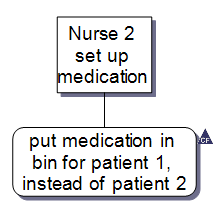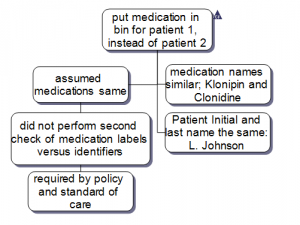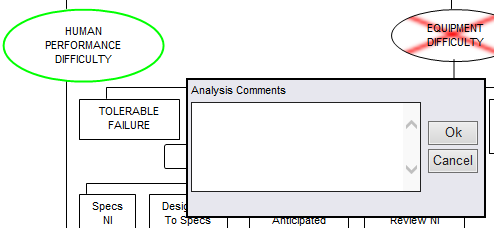Elements of a Credible Effective Root Cause Analysis
Many people ask “What makes a good RCA?”. This question as stated is difficult to answer due to the fact that “good” is a very subjective term. What is good for one may not be good enough for another and vice versa. But, if we replace one simple word in that question we can make it a much more objective question. By changing that term to “credible” and/or “effective,” now we have a good starting point as both these terms have investigative standards and principles behind them. Let’s start with some definition:
Credible: This term is defined as “able to be believed; convincing.” Let’s focus on an investigation for our example and ask what would make our investigation able to be believed? One simple answer comes to mind, the ability to see the relationship between our Root Causes, our Causal Factors, and our Incident. That “Specific” relationship as we call it is dependent on the data collected in an investigation and ability for your audience to be able to connect those “dots” if you will.
Effective: This term is defined as “successful in producing a desired or intended result”. This focuses on the outcome of an action and what the desired results or end point is. For investigations the outcome or desired result is to implement fixes and Corrective Actions that will in the future reduce the risk of or remove the risk of a reoccurrence. The audience’ ability to see the effectiveness of the Corrective Actions is key.
So if we add both these words together and use them in combination to define an investigation we can now see how to answer the initial question.
Credible Root Cause Analyses
Let’s begin with the word credible and provide some guidance for our TapRooT® Users. When I look at and review any investigation the credibility is established for me in two techniques, the SnapCharT® and the Root Cause Tree®.
SnapCharT®
Let me put this as simply and as plainly as I can, when building your chart the team should put ALL information into that SnapCharT®. No matter how insignificant something may seem, or how common place something may be it should be on the chart for transparency and for use during the analysis on the Root Cause Tree®. Anytime you make a conscious effort to leave information off the chart you open yourself up for questions and you reduce the ability of your audience to “connect the dots” as mentioned above. This lowers your credibility significantly.
This can also lead to issues when your audience tries to understand the relationship between the Root Causes you have chosen on the Root Cause Tree® and the information on the SnapCharT®. This relationship should be as “transparent” as possible and the audience should not have to work to figure out the relationship. There should be a direct link between data on the chart and the Root Causes from the Root Cause Tree®.
 …
…
Root Cause Tree®
Once the thorough “transparent” SnapCharT® is completed and the investigation move into the Root Cause Tree® to analyze your Causal Factors, documentation is the key to credibility. Three statements that can kill credibility are: “I believe,” “I think,” and “I am pretty sure,” Each one of these statements provides your audience with doubt as to what you truly know. This is why I always recommend the use of the Root Cause Tree® Dictionary and Analysis Comments in the Root Cause Tree® for documentation. This provides the connection and the defendable path for you and your audience.
As the Tree is analyzed the investigation should have data from the SnapCharT® to confirm each selection on the Root Cause Tree® as well as one or many questions answered as a yes from the Dictionary. Take that data (cut and paste) and put that into the Analysis Comments in the TapRooT® Software to document “why” you answer yes, and to show the audience your reasoning.

 .
.
Effective Investigations
We have explored the “Credibility” of analyses so now we need to look at the Effective portion. We concluded that this measure is tied to the effectiveness of the Corrective Actions we present and implement. An analysis by itself cannot be effective without corrective and preventative actions that solve the Root Causes and prevent or reduce the likelihood of recurrence in the future.
When developing our Corrective Actions for the Root Causes we find during our analyses we have to consider the following items for each action:
Implementation: The act of putting the specific action in place in our systems and organization
Verification: This is a short-term measure of implementation. How are we going to ensure that what we proposed as the Corrective Action was implemented properly.
Validation: This is a long-term measure of effectiveness. This plan is based around the question, “What will success look like?” built with a plan to measure the progress (or regression) towards that outcome.
Most companies do a pretty effective job of the Implementation phase, implementing actions for every root cause. But in follow-up to these actions they do nothing; seemingly they wash their hands of the issue and say they are done. Implementation by itself does not ensure success. The two measurements above are very important because the provide some level of oversight for the actions and are a quality control check to make sure the actions hit the mark. If for any reason the Validation shows that the action is not having the desired effect the action needs to be revisited and revised if necessary starting the cycle again.
If Corrective Actions are implemented and not measured you increase the risk of the implementation falling short, or the action itself not actually having a positive impact on your systems and employees.
Summary
In the end, the credibility of your analysis is dependent on the data you collect, the quality (not quantity) of the data, and how it is used to confirm any answers found on the Root Cause Tree®. The effectiveness is dependent on the success of the corrective actions implemented and the longer term sustained success of the changes in the system to stop future recurrence. By following the 7-Step Process flow, and the Core techniques highlighter here within the TapRooT® process the system will guide you through these steps and aid you in successfully providing your management with a very Credible and Effective Investigation.
Want to learn more?
Our 5-Day TaprooT® Advanced Root Cause Analysis Team Leader Training provides all of the essentials to perform a root cause analysis plus advanced techniques. You also receive a single user copy of TapRooT® software in the 5-day course. The software combines incident identification, analysis, and dynamic report writing into one seamless process.



